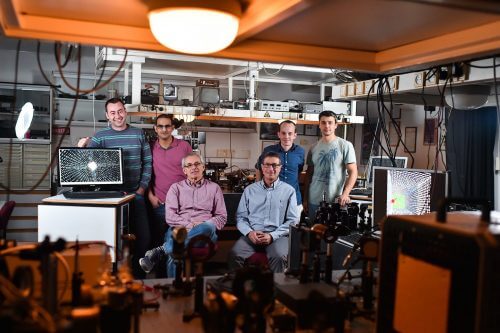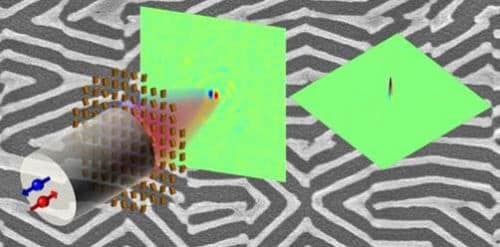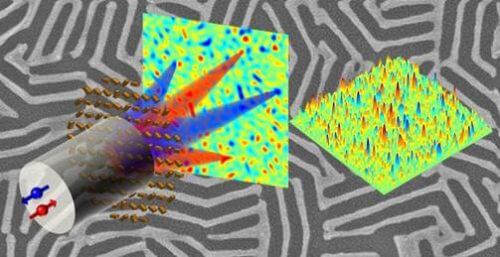A team of researchers led by Prof. Erez Hasman from the Technion Reports a groundbreaking scientific discovery that simulates a photonic "big bang" on the nanometer scale

The journal Science reports on a scientific discovery revealed by the research group of Prof. Erez Hasman from the Faculty of Mechanical Engineering and the Russell Berry Nanotechnology Institute (RBNI) at the Technion. The discovery demonstrates a transition from an ordered physical system to an optically disordered system on the nanometer scale, and demonstrates a photonic "big bang" on the nanometer scale under laboratory conditions, similar to existing models in cosmology.
"Our research deals with the development of optical components on the nanometer scale and understanding the interaction between light and small structures," explains Prof. Hasman, head of the Nano Optics Laboratories in the Faculty of Mechanical Engineering at the Technion. "The purpose of the current study published in the journal Science and carried out inspired by the "Big Bang" model in cosmology was to demonstrate how a physical system goes from a structure of order to disorder. We tried to understand the mechanism of the topological phase transition (transition from an ordered state to extreme disorder as a result of symmetry breaking) on the nanometer scale."
The research was carried out by the nanooptics research group led by Prof. Hasman, which includes research students Elhanan Magid, Michael Yanai, Arkady Fireman, Igor Yulevich and the researcher Dr. Vladimir Kleiner.
The "photonic bang" was demonstrated using nanoscale metasurfaces based on tiny silicon antennas (nanoantennas). "Using nanoantennas that we produced in the laboratory using silicon technology, we developed a way to control disorder in the system - by increasing entropy," explains Prof. Hasman.

"Light consists of photons, massless particles that move at the speed of light. Each photon behaves like a spinning top spinning clockwise or counterclockwise. (In scientific terminology: positive spin or negative spin).
When you go from an ordered state to a state where there is a little disorder, that is, you slightly change the angle of the nanoantennas, a "photonic spin-hole" occurs, a spatial splitting of the photons with opposite spins, photons with a positive spin move in a certain direction and those with a negative spin move in the opposite direction. This is a very small split on the nanometer scale, so the researchers used the idea of Prof. Yakir Aharonov from Tel Aviv University, called Weak quantum measurement, to measure a nanometric separation between the two spin states of the light particles. With increasing disorder and when the system reaches a critical point, where there is total disorder, a "big bang" occurs in nanooptics, i.e. scattering of the photons with opposite spins in all directions (in scientific terminology - the "random Rashba effect"). The breaking of the symmetry in the system manifests itself in the creation of optical vortices called topological defects. Optical vortices were created as a result of an interaction between the path of the photon (the particle of light) and its spin. The measurement revealed a very unique phenomenon - a dramatic spatial increase in the number of optical vortices and the creation of repulsion between the vortices as a result of disorder."


The discovery is a global scientific breakthrough that was carried out as mentioned for the first time in Prof. Hasman's laboratory at the Technion and it describes a photonic "big bang", meaning a "big bang" on a nanometer scale based on light.
The research inspires the understanding of disorder in the solid state and will greatly contribute to the field of spintronics. In addition, it opens up possibilities for designing photonic materials while controlling their degree of disorder.
Prof. Hasman is a world-renowned expert in the field of nanophotonics - interaction of photons with nanoscale structures, and founded the field of spin optics. In recent years, Prof. Hasman, together with the members of his research group, developed arrays of silicon nanoantennas, with which it is possible to shape light beams and combine a large number of optical components in a single nanometer component.
Prof. Hasman proudly notes the great achievements of his group "For the past four years, we have published a groundbreaking article every year in the journal Science. These achievements earned Elhanan Magid the prestigious Wolf Prize for outstanding doctoral students in 2017. My research group laid the foundations in 2001 for the field of photonic nanoscale metasurfaces, which is now considered one of the hottest fields in optics, and many research laboratories in the world are engaged in this field."
Prof. Hasman's group includes researchers from various disciplines, physics and engineering sciences, engaged in both basic research and applied research leading to many applications in the high-tech industry.
Prof. Hasman has a fruitful collaboration with Stanford University in the USA, which yields groundbreaking research and joint research projects, and also allows the researchers in his group to lead research with colleagues in the USA. The research was supported by the National Science Foundation (ISF) and the components were realized at the Zispel Center for Nanoelectronics (MNFU).
For an article in the journal SCIENCE
Watch an explanatory video about the study:

One response
I didn't understand what exactly could be done with it